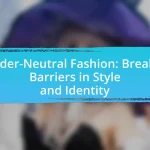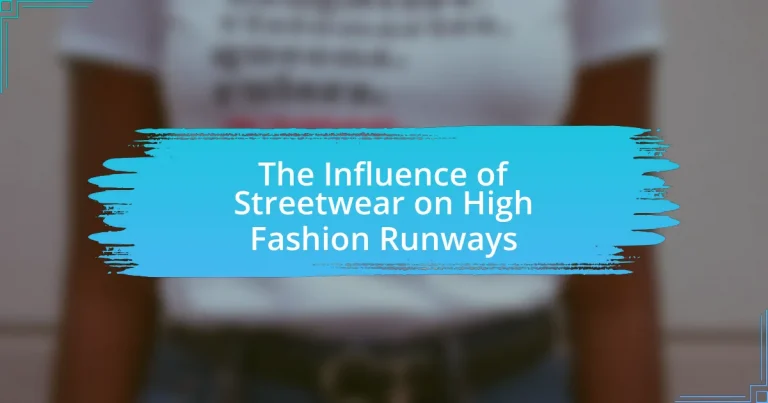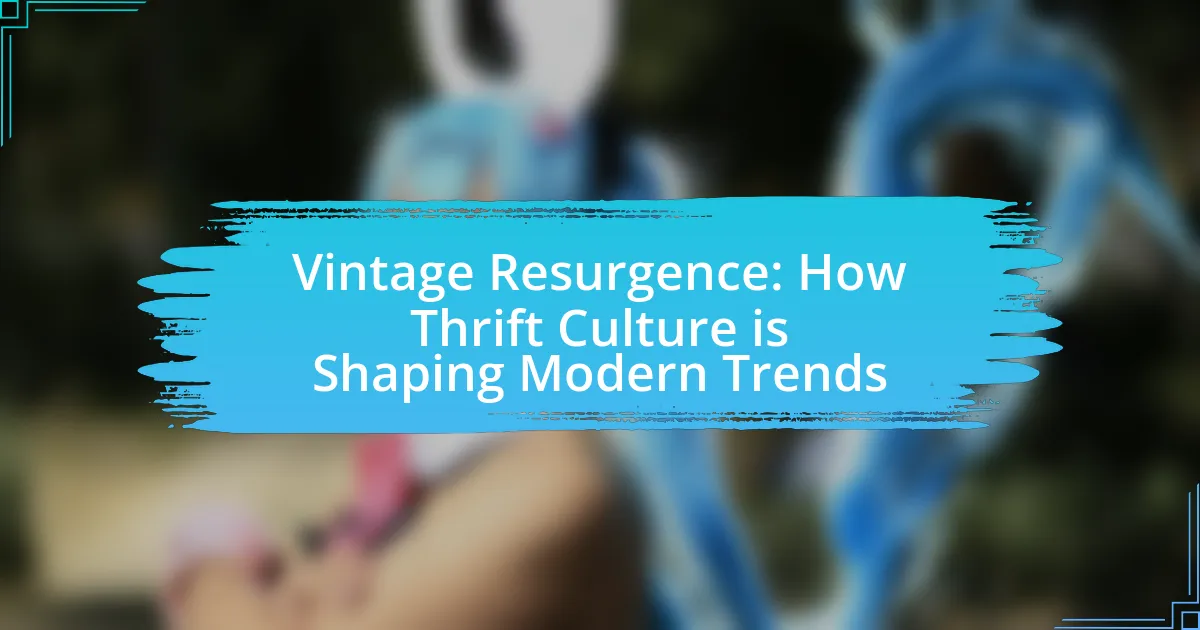The article examines the significant influence of streetwear on high fashion runways, highlighting how designers like Virgil Abloh and Demna Gvasalia have integrated casual aesthetics and urban culture into luxury collections. It traces the emergence of streetwear from its roots in youth subcultures, such as hip-hop and skateboarding, to its current status as a dominant force in fashion. The piece discusses the evolving perception of streetwear within the industry, the role of collaborations between streetwear and high fashion brands, and the impact of social media on this trend. Additionally, it explores future trends, innovations, and practical insights for emerging designers looking to blend streetwear with high fashion.

What is the Influence of Streetwear on High Fashion Runways?
Streetwear significantly influences high fashion runways by integrating casual aesthetics and urban culture into luxury collections. Designers such as Virgil Abloh and Demna Gvasalia have blurred the lines between streetwear and high fashion, showcasing oversized silhouettes, graphic tees, and sneakers on prestigious platforms like Paris Fashion Week. This shift reflects a broader cultural acceptance of streetwear, evidenced by the rise of collaborations between high-end brands and streetwear labels, such as the partnership between Louis Vuitton and Off-White. The incorporation of streetwear elements into high fashion not only democratizes luxury but also resonates with younger consumers, driving sales and engagement in the fashion industry.
How did streetwear emerge as a significant trend in fashion?
Streetwear emerged as a significant trend in fashion through its roots in urban culture, particularly influenced by skateboarding, hip-hop, and youth subcultures in the late 20th century. The rise of brands like Stüssy in the 1980s and Supreme in the 1990s exemplified this movement, as they combined casual aesthetics with a rebellious spirit, appealing to a generation seeking authenticity and self-expression. The trend gained momentum as celebrities and influencers adopted streetwear styles, further legitimizing its presence in mainstream fashion. By the 2010s, major fashion houses began incorporating streetwear elements into their collections, showcasing the genre’s impact on high fashion runways and solidifying its status as a dominant force in the industry.
What cultural movements contributed to the rise of streetwear?
The rise of streetwear was significantly influenced by cultural movements such as hip-hop, skateboarding, and punk. Hip-hop culture, emerging in the late 1970s and 1980s, popularized casual, oversized clothing and brand-centric styles, which became synonymous with streetwear. Skateboarding culture, particularly in the 1980s and 1990s, introduced graphic tees and baggy pants, further shaping the aesthetic of streetwear. Additionally, the punk movement of the 1970s emphasized individuality and anti-establishment sentiments, which resonated with streetwear’s ethos of self-expression and rebellion against mainstream fashion. These movements collectively contributed to the development of streetwear as a distinct fashion genre that reflects urban culture and youth identity.
How has streetwear evolved over the years?
Streetwear has evolved from a niche subculture in the 1980s and 1990s, characterized by casual, comfortable clothing influenced by skate and hip-hop culture, into a dominant force in global fashion. Initially, brands like Stüssy and Supreme emerged, focusing on limited releases and a strong community ethos, which fostered exclusivity and hype. Over the years, streetwear has increasingly integrated with high fashion, as seen in collaborations between streetwear brands and luxury houses such as Louis Vuitton and Gucci, which have embraced streetwear aesthetics and casual silhouettes. This evolution is evidenced by the rise of streetwear’s presence on high fashion runways, where designers now incorporate elements like oversized fits, graphic tees, and sneakers, reflecting a shift in consumer preferences towards more relaxed and accessible styles. The 2020s have further solidified streetwear’s status, with major fashion weeks showcasing collections that blend streetwear with traditional tailoring, indicating its lasting impact on the fashion industry.
Why is streetwear important in the context of high fashion?
Streetwear is important in the context of high fashion because it represents a cultural shift that democratizes fashion and influences luxury brands. This genre of clothing, which emerged from urban youth culture, has been embraced by high fashion designers and houses, leading to collaborations that merge street aesthetics with luxury craftsmanship. For instance, brands like Off-White and Supreme have successfully integrated streetwear elements into high fashion, resulting in increased visibility and relevance for both sectors. The blending of these styles has reshaped runway presentations, making them more accessible and reflective of contemporary societal trends, thus highlighting the significance of streetwear in redefining luxury fashion narratives.
What are the key characteristics of streetwear that appeal to high fashion designers?
The key characteristics of streetwear that appeal to high fashion designers include its casual aesthetic, cultural relevance, and emphasis on individuality. Streetwear’s casual aesthetic allows for comfortable yet stylish designs, which resonate with contemporary fashion trends. Its cultural relevance, often rooted in urban environments and youth culture, provides high fashion designers with fresh inspiration and a connection to diverse communities. Additionally, the emphasis on individuality in streetwear encourages personal expression, which aligns with the growing demand for unique and personalized fashion experiences in high fashion. These characteristics have led to collaborations between streetwear brands and luxury fashion houses, further blurring the lines between the two sectors.
How does streetwear challenge traditional fashion norms?
Streetwear challenges traditional fashion norms by prioritizing comfort, accessibility, and self-expression over the exclusivity and formality typically associated with high fashion. This shift is evident in the rise of casual attire, such as oversized silhouettes and graphic tees, which have become staples in both streetwear and luxury collections. The integration of streetwear into high fashion runways, exemplified by brands like Off-White and Supreme collaborating with luxury houses, demonstrates a blurring of lines between casual and formal wear. Additionally, streetwear’s emphasis on cultural references and community engagement contrasts sharply with the often elitist nature of traditional fashion, making it more relatable and inclusive for a broader audience.
What are the main ways streetwear influences high fashion runways?
Streetwear influences high fashion runways primarily through the incorporation of casual aesthetics, the blending of cultural references, and the emphasis on inclusivity and diversity. High fashion designers increasingly adopt streetwear’s relaxed silhouettes and graphic designs, reflecting a shift towards comfort and practicality in luxury fashion. For instance, brands like Off-White and Balenciaga have successfully merged streetwear elements into their collections, showcasing oversized fits and bold logos. Additionally, streetwear’s roots in urban culture and youth movements inspire high fashion to embrace diverse cultural narratives, as seen in collections that celebrate street art and music. This influence also promotes a more inclusive approach to fashion, as streetwear often prioritizes accessibility and relatability, challenging traditional elitism in high fashion.
How do high fashion brands incorporate streetwear elements into their collections?
High fashion brands incorporate streetwear elements into their collections by blending casual aesthetics with luxury materials and craftsmanship. This fusion often includes oversized silhouettes, graphic prints, and urban-inspired accessories, reflecting the relaxed yet edgy vibe of street culture. For instance, brands like Balenciaga and Off-White have successfully integrated hoodies, sneakers, and street-style layering into their runway shows, demonstrating a shift in consumer preferences towards more comfortable and versatile fashion. The collaboration between high fashion and streetwear has been validated by the increasing presence of streetwear designers in prestigious fashion weeks, highlighting the growing acceptance and influence of streetwear within the luxury market.
What role do collaborations between streetwear and high fashion brands play?
Collaborations between streetwear and high fashion brands play a crucial role in bridging the gap between casual and luxury fashion, enhancing brand visibility and cultural relevance. These partnerships often result in innovative designs that attract diverse consumer demographics, merging the accessibility of streetwear with the exclusivity of high fashion. For instance, the collaboration between Supreme and Louis Vuitton in 2017 generated significant buzz and sales, exemplifying how such partnerships can elevate brand status and create a cultural phenomenon. This synergy not only drives sales but also influences trends, as seen in the increasing presence of streetwear aesthetics on high fashion runways, thereby reshaping the fashion landscape.
How has the perception of streetwear changed in the fashion industry?
The perception of streetwear in the fashion industry has evolved from being viewed as a niche subculture to a dominant force influencing high fashion. Initially, streetwear was associated with youth culture and casual attire, often dismissed by traditional fashion elites. However, over the past decade, major luxury brands like Gucci and Balenciaga have incorporated streetwear elements into their collections, signaling a shift in acceptance. This transformation is evidenced by the rise of collaborations between streetwear labels and high-end designers, such as the partnership between Off-White and Louis Vuitton, which has further legitimized streetwear within the luxury market. As a result, streetwear is now recognized not only for its cultural significance but also for its impact on contemporary fashion trends and runway aesthetics.
What impact has social media had on the acceptance of streetwear in high fashion?
Social media has significantly accelerated the acceptance of streetwear in high fashion by providing a platform for brands and influencers to showcase and popularize this style. The rise of platforms like Instagram and TikTok has allowed streetwear brands to reach a global audience, enabling them to gain visibility and credibility within the fashion industry. For instance, collaborations between high-end designers and streetwear labels, such as the partnership between Louis Vuitton and Off-White, have been heavily promoted on social media, leading to increased consumer interest and acceptance. Additionally, social media trends often dictate fashion cycles, with streetwear aesthetics becoming mainstream as influencers and celebrities adopt and promote these styles, further legitimizing their place in high fashion.
How do fashion critics view the merging of streetwear and high fashion?
Fashion critics generally view the merging of streetwear and high fashion as a transformative and innovative shift in the fashion landscape. This fusion is seen as a democratization of fashion, where traditional boundaries are blurred, allowing for greater creativity and inclusivity. Critics highlight that brands like Off-White and Balenciaga have successfully integrated streetwear aesthetics into luxury collections, reflecting a cultural shift towards casual, everyday wear in high fashion. The rise of collaborations between streetwear labels and luxury houses, such as the partnership between Nike and Dior, further exemplifies this trend, showcasing how high fashion is increasingly embracing street culture.
What are the potential future trends of streetwear in high fashion?
The potential future trends of streetwear in high fashion include increased collaboration between luxury brands and streetwear labels, a focus on sustainability, and the integration of technology in fashion. Collaborations, such as those seen between brands like Off-White and Nike, demonstrate how high fashion is embracing streetwear aesthetics to attract younger consumers. Sustainability is becoming a priority, with brands like Gucci and Stella McCartney leading the way in eco-friendly practices, reflecting a growing consumer demand for responsible fashion. Additionally, the use of technology, including augmented reality and digital fashion shows, is likely to reshape how streetwear is presented on high fashion runways, as evidenced by Balenciaga’s innovative digital presentations. These trends indicate a continued blending of streetwear and high fashion, driven by consumer preferences and technological advancements.
How might streetwear continue to evolve on high fashion runways?
Streetwear will likely continue to evolve on high fashion runways by integrating more sustainable practices and innovative materials. Designers are increasingly adopting eco-friendly fabrics and production methods, reflecting a growing consumer demand for sustainability in fashion. For instance, brands like Off-White and Balenciaga have already begun to incorporate recycled materials into their collections, demonstrating a shift towards environmentally conscious streetwear. Additionally, the blending of streetwear aesthetics with luxury craftsmanship will further redefine high fashion, as seen in collaborations between streetwear labels and established fashion houses, which have gained significant traction in recent years. This evolution indicates that streetwear will not only influence design but also reshape the values and practices of high fashion.
What innovations could emerge from the ongoing relationship between streetwear and high fashion?
The ongoing relationship between streetwear and high fashion could lead to innovations such as sustainable materials and inclusive sizing. High fashion brands are increasingly adopting streetwear’s emphasis on casual, functional designs, which can drive the development of eco-friendly fabrics that appeal to environmentally conscious consumers. For example, brands like Stella McCartney have pioneered the use of recycled materials, influenced by streetwear’s focus on practicality. Additionally, the blending of these two styles encourages a broader range of sizes, as streetwear often prioritizes comfort and accessibility, prompting high fashion to expand its offerings to cater to diverse body types. This shift is evidenced by collaborations like those between Nike and high-end designers, which have successfully merged streetwear aesthetics with luxury fashion, showcasing the potential for innovation in both design and consumer inclusivity.
What practical insights can be drawn from the influence of streetwear on high fashion?
The influence of streetwear on high fashion reveals practical insights such as the importance of inclusivity and the blending of casual and luxury aesthetics. High fashion brands have increasingly adopted streetwear elements, leading to a democratization of fashion where luxury is accessible and relatable. For instance, brands like Balenciaga and Off-White have successfully integrated streetwear styles, which has resulted in increased consumer engagement and sales. This shift demonstrates that high fashion can thrive by embracing cultural trends and appealing to younger demographics, as evidenced by the rise in popularity of collaborations between streetwear labels and luxury houses.
How can emerging designers leverage streetwear trends in their collections?
Emerging designers can leverage streetwear trends in their collections by incorporating casual silhouettes, bold graphics, and cultural references that resonate with contemporary youth culture. This approach aligns with the growing consumer demand for authenticity and individuality in fashion, as evidenced by the rise of brands like Off-White and Fear of God, which have successfully blended high fashion with streetwear elements. By utilizing materials such as denim, jersey, and technical fabrics, designers can create versatile pieces that appeal to a broader audience, reflecting the streetwear ethos of comfort and functionality. Additionally, engaging with social media platforms for marketing and community building allows emerging designers to connect directly with their target demographic, further enhancing their relevance in the market.
What strategies can brands adopt to successfully blend streetwear with high fashion?
Brands can successfully blend streetwear with high fashion by incorporating urban aesthetics, collaborating with streetwear designers, and utilizing innovative marketing strategies. Urban aesthetics can be integrated through the use of bold graphics, oversized silhouettes, and casual materials, which resonate with streetwear culture while maintaining high fashion’s quality. Collaborations with established streetwear designers, such as the partnership between Louis Vuitton and Off-White’s Virgil Abloh, create a bridge between the two worlds, attracting diverse consumer bases. Innovative marketing strategies, including social media campaigns and influencer partnerships, can amplify brand visibility and appeal to younger demographics that value both streetwear and high fashion. These strategies have been validated by the increasing presence of streetwear elements in major fashion shows and the growing sales of luxury brands that embrace this fusion.















